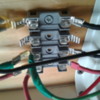Well folks I spent nearly a $200 bill on fast track and had the most frustrating 2 hours I have ever experienced with model trains. Once assembled into a figure 8 I had nothing but connectivity problems. I fiddled around looking for any obvious problems and found none. Clearly two or more joints were bad at any given time to provide an open loop and stop the train. The loco would pass a track joint and stop. Press the joint down or lift it slightly and magically the loco would move. Some fast track joints were actually hot indicating some internal arching. I reconfigured my track into an oval with no joy. There is simply no explanation. I finally gave up in disgust.
Using a small transformer would explain it. Using the FasTrack feeder wire would explain it. Not enough amperage can flow.
Bad luck and getting a large batch of this production run would explain it. Fix it link The bend is only a 1/16th of an inch so.
Sorry to hear that you had that bad of an experience. Use a meter or lighted car to find the bad joints.
Moonman offers some practical solutions that really go a long way to solving the problem. Just one point of clarification.
The lack of amperage is only an issue if the train is coming to a stop because the transformer has gone into overload. In other words, the power draw of the train can exceed the available volume of electricity, forcing the transformer's breaker to open to avoid damage.
Using a common analogy, amps would be the volume of water flowing through a pipe, and the water pressure would be the voltage.
If you are running one train set level locomotive on a large layout, you can use a train set level transformer, such as a CW-80, to your heart's content as long as you provide enough feeder wires (16 gauge or larger) to maintain the voltage level. Again, amperage represents the volume of electricity available. Voltage is the flow.
The problems being discussed here have to do with that center pin on FasTrack. I have experienced similar problems on carpet layouts for Christmas. A little tweaking, like gunrunnerjohn suggests (and the use of small binding clips, and an chemical electrical conductor such as DeoxIT DN5 on the center pin, as he has suggested in the past), takes care of the problem.
Every track system has varying problems with re-use, but FasTrack can have problems fresh out of the package if the track is put together incorrectly.
I plan on using FasTrack on a larger permanent layout in the future. I will test every joint on installation and include plenty of feeder wires from a bus system -- at least every 10 feet. And, of course, using a decent power supply to make sure there is enough power to handle higher amp draws of big locomotives.










